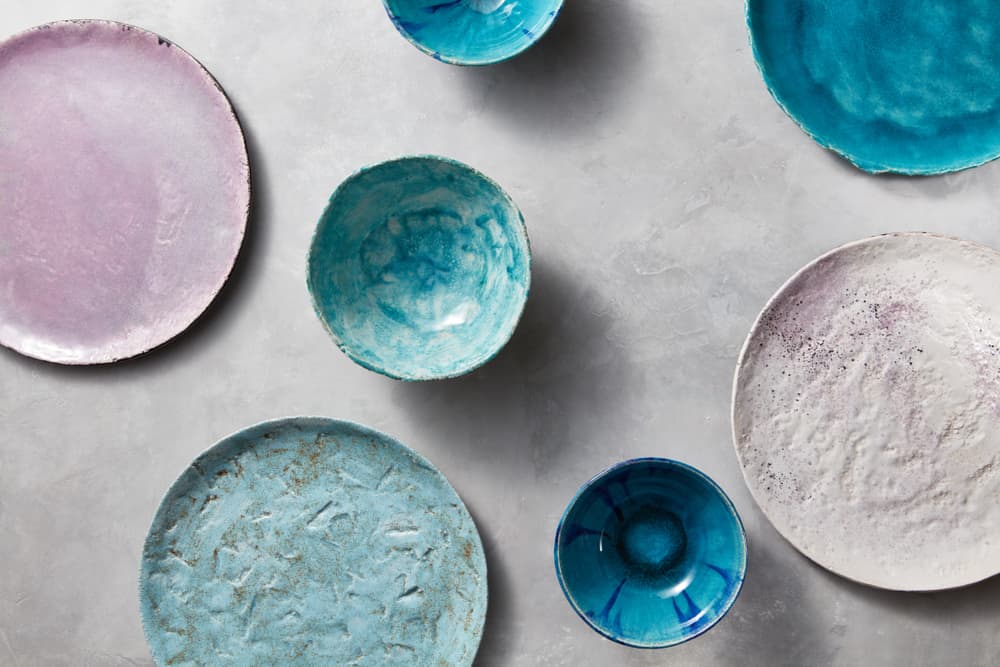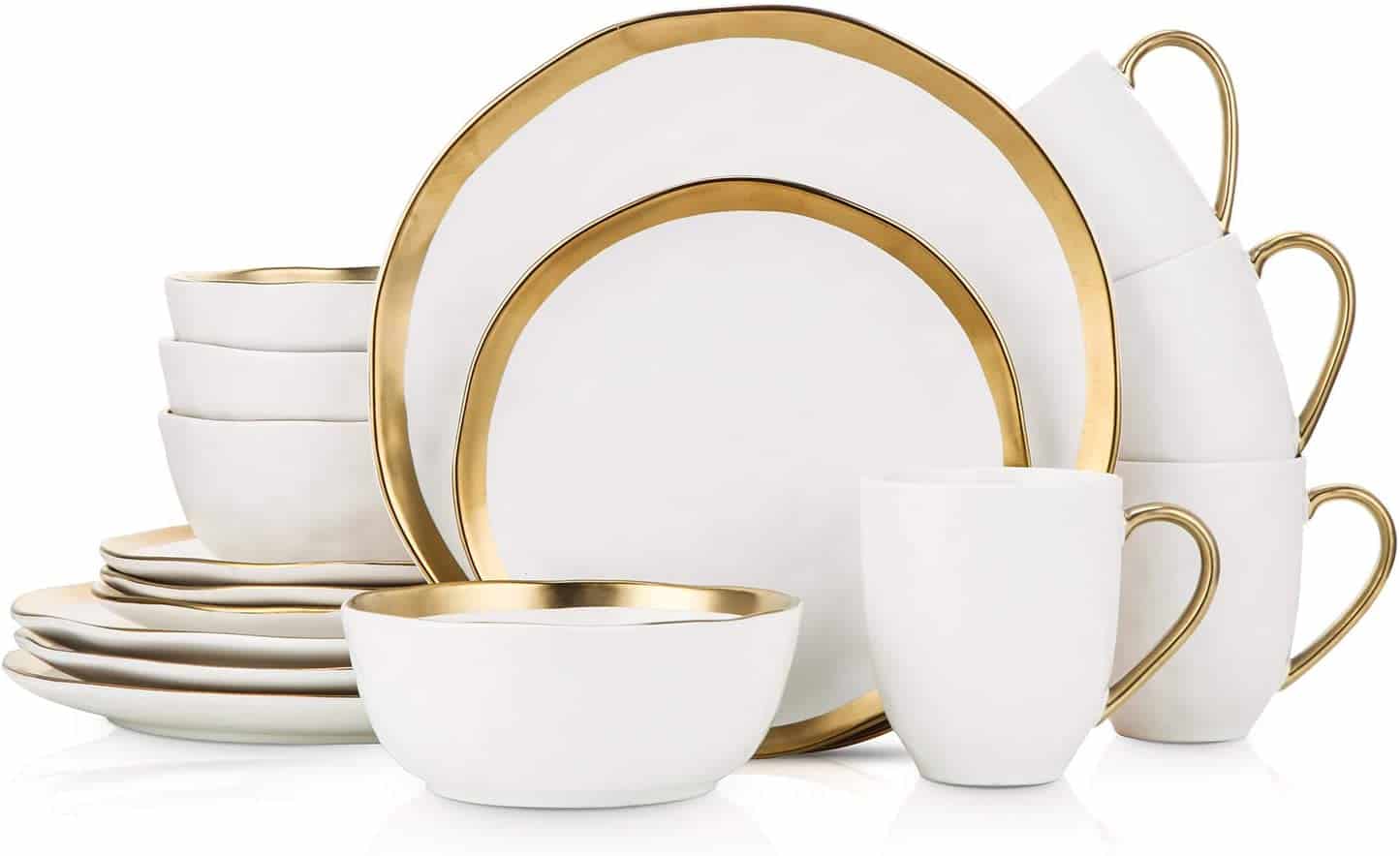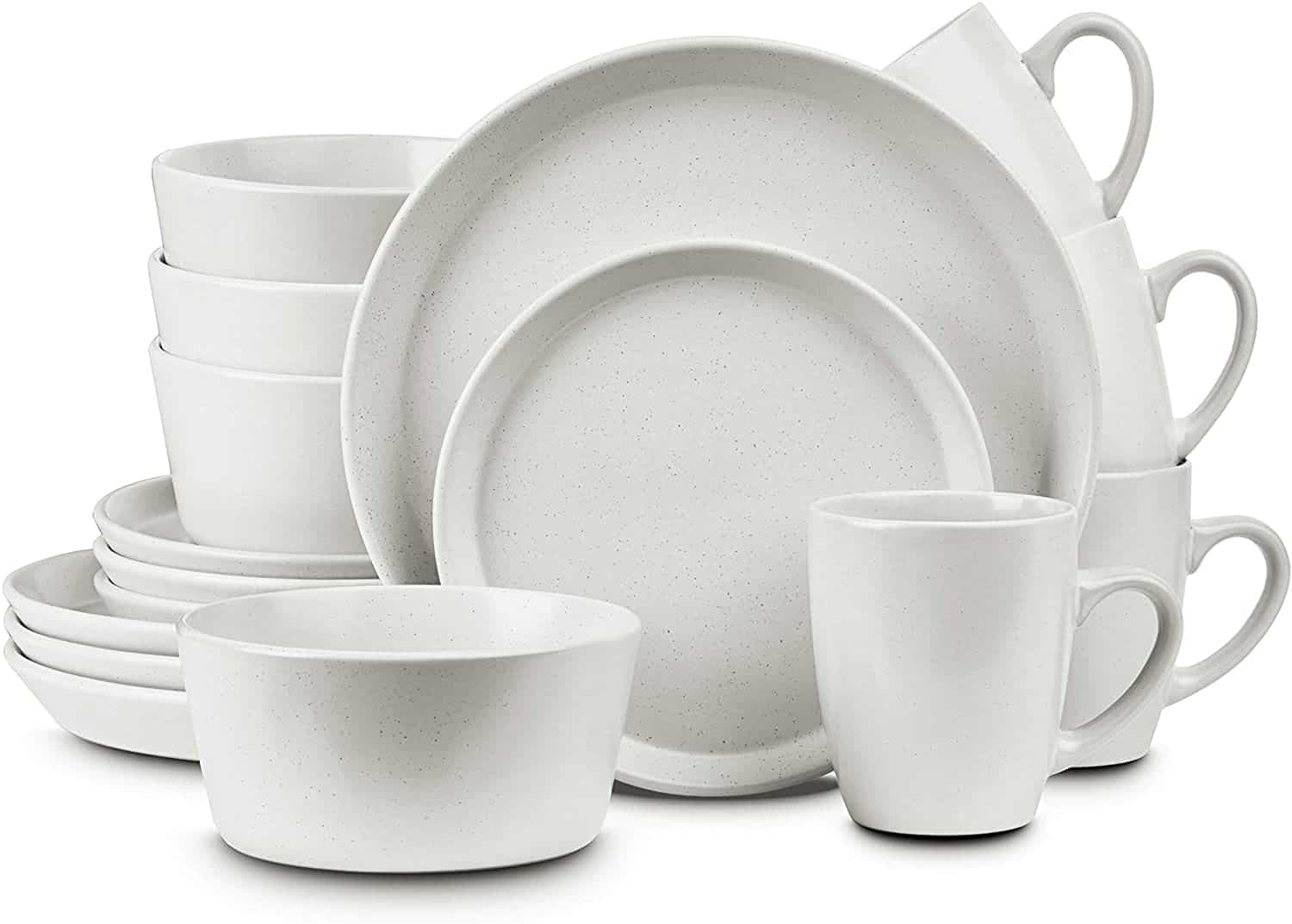Stoneware and porcelain are arguably the most popular types of ceramics. At the first glance, they might seem similar or even identical, but these two materials actually have more differences than similarities.
In this article, we’ll compare stoneware with porcelain, and explain which one is better for you and your home.
Table of Contents
Stoneware 101
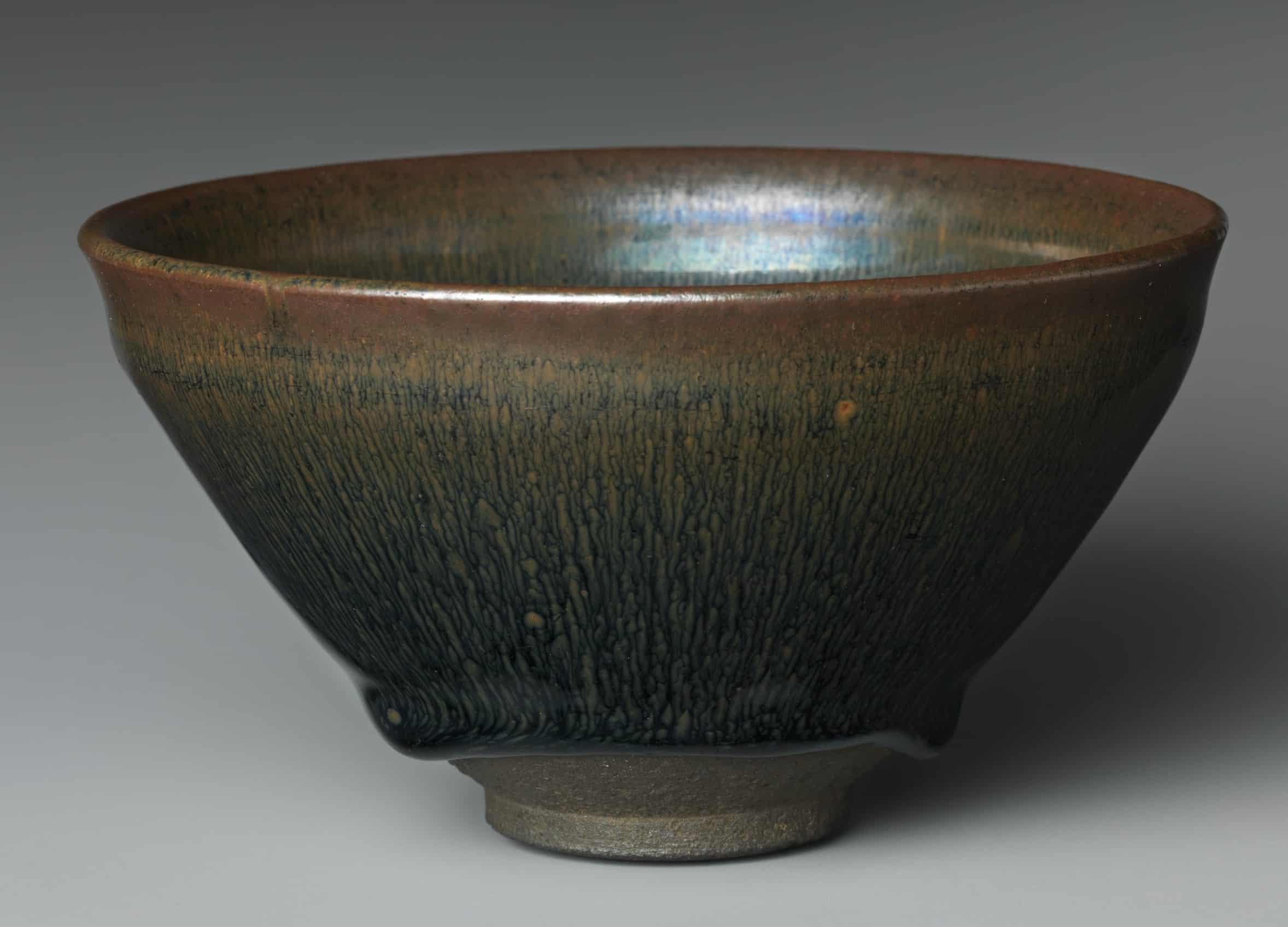
Stoneware is a type of ceramic made of non-refractory clay, resulting in durable, non-porous material. As a result, it doesn’t need to be glazed, unlike some other types of ceramics. Stoneware doesn’t soak up liquids regardless of glazing and is perfect to use in daily life.
It was one of the first types of ceramics made by humans. There’s evidence that it was mass-produced in Indus Valley Civilisation as early as 2600 BC. Today, stoneware is a popular material for dinnerware, as it can be used in ovens, dishwashers, and microwaves.
Porcelain 101
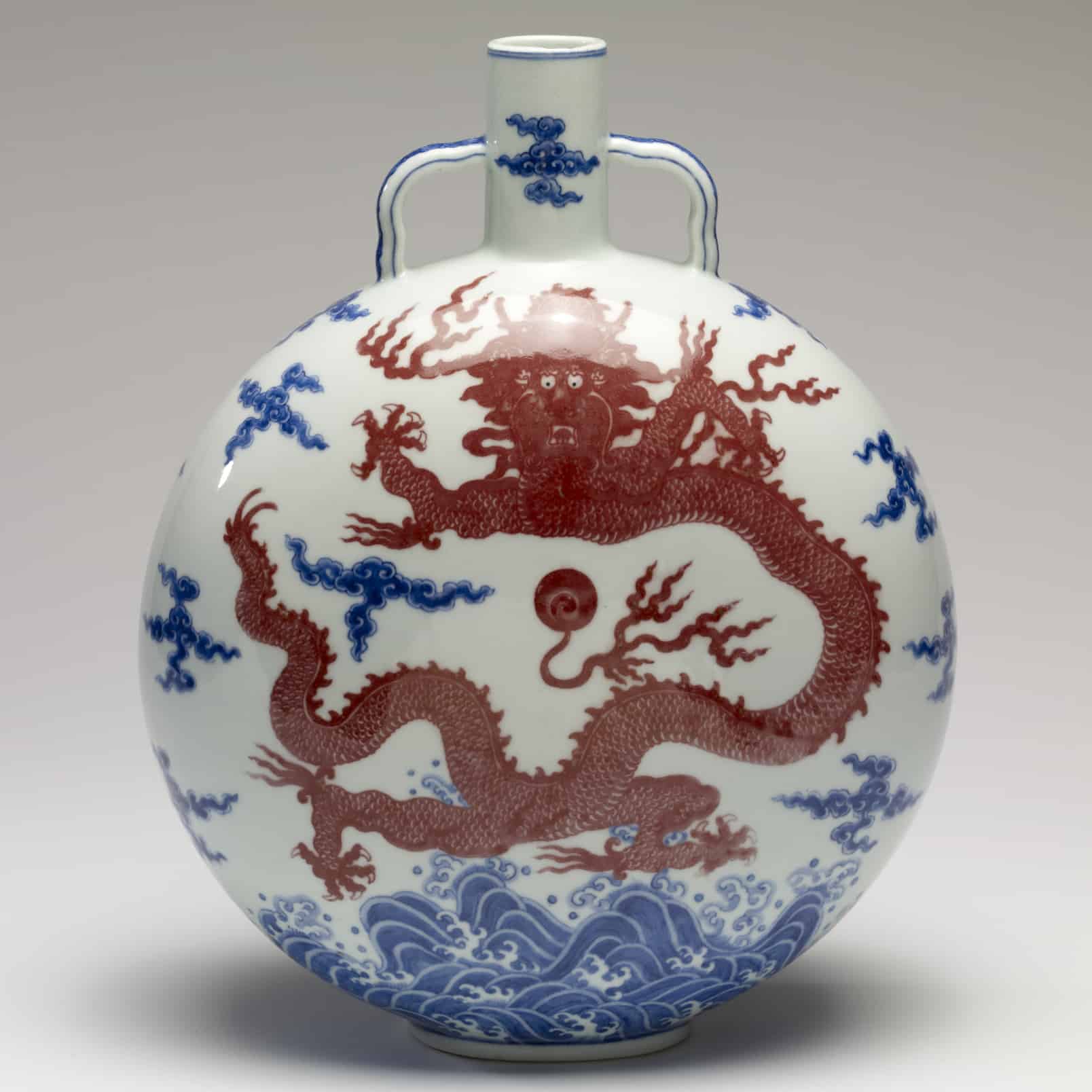
Porcelain is a type of ceramic material that is made from kaolin clay that is fired at a high temperature. It’s distinguished from other types of ceramics by its smooth, white surface. The unique properties of porcelain allow it to be formed into many intricate shapes.
Porcelain originated in China thousands of years ago and was first introduced to Europe in the 16th century. It quickly became the most prized type of ceramic for its beauty and durability. It took over 200 years until Europeans managed to recreate porcelain themselves.
Porcelain can be used for a variety of purposes, including dinnerware, vases, figurines, sinks, and even countertops. To this day porcelain is seen as a sign of affluence and elegance.
Stoneware vs. Porcelain
So, which one is better, stoneware or porcelain? In the following sections, we’re going to compare the most important characteristics of these types of ceramics and help you understand the most important differences separating them.
Appearance
While porcelain is white, stoneware can have many different colors, depending on its exact composition. Even what’s considered “white” stoneware is not as white as porcelain, and has a grey or brown tint.
Also, unlike porcelain, which is translucent and lets through some light, stoneware is opaque. However, keep in mind that the appearance of these two types of ceramics is also dictated by post-firing treatment.
Finally, most stoneware these days has added color, which means you can have stoneware of any color you desire. On the other hand, no one makes colorful porcelain, so the ware base will always be white, and color glaze or paint will be reserved for adornments.
Glaze
The glaze is applied to ceramics during the firing process to enhance their durability, water absorption, or appearance. There are many different types of glazes, each resulting in different properties and colors.
Stoneware is rarely glazed and decorated, but when it is, it’s usually with salt. Thanks to a relatively high temperature in the kiln, salt can react with silica found in clay and result in a layer of glaze. It’s glossy and colorless, but can be purple, blue, or brown if you add certain chemicals.
On the other hand, porcelain is commonly glazed and decorated. Each renowned porcelain manufacturer had its own iconic patterns with unique motifs that were either displayed with glaze or paint.
Types
There are many types of ceramics that could be considered stoneware. In Europe, most ceramics that require a firing temperature between earthenware and porcelain is considered to be stoneware.
In East Asia, most stoneware is considered to be porcelain, or “near porcelain”. For example in China, Jian ware was made during the Song dynasty (10th-13th centuries), and Longquan celadon was manufactured from the 3rd to 14th century.
These types of ceramics were highly prized until true porcelain pieces became more common in the 14th century. After that, various stoneware ceramics continued to be made but dropped in quality as they were reserved for the poorer.
On the other hand, there are three main types of porcelain. Hard-paste porcelain, also called true porcelain is the most prized and requires the highest firing temperature. It’s the most durable, hard, and translucent type of porcelain.
Then, there’s soft-paste porcelain, which was a result of European attempts to recreate true porcelain made in China. Soft-paste porcelain is made of clay and frit, including lime and steatite.
Because of its composition, such porcelain wasn’t like plastic and couldn’t be formed into more intricate shapes. Wares made of this type of porcelain are less durable and not commonly manufactured today.
Finally, there’s bone china, which was first produced in 18th century England. It’s made of two parts bone ash, one part china stone, and one part kaolin. It’s lighter than hard-paste porcelain and is popular to this day.
Composition and Production
Stoneware composition can differ vastly from piece to piece, but usually, it’s made of non-refractory fire clays that can be combined with ball clay, feldspar, quartz, or chamotte in varying proportions. Stoneware clay bases are called mid-fire clays.
On the other, porcelain is considered to be high-fired clay and requires kaolinite. It has a high melting point of about 3200 °F (1750 °C). Because of that, it’s combined with other materials that lower the melting point, including feldspar, quartz, and alabaster.
What’s considered “true” porcelain requires a firing temperature of about 2650 °F (~1450 °C), while stoneware can be fired starting from 2010 °F (1100 °C). It makes porcelain much harder to produce, which was the reason for its delayed production in Europe.
Physical Properties
Stoneware has an absorption factor ranging from 2% to 5%, which is on the lower side of absorption rates in ceramics. It makes it perfectly fine to use in daily life and holds liquids like water in stoneware vessels.
For comparison, porcelain has an absorption factor of just 0% to 1%, making it the least absorbent mainstream ceramic out there. That’s the reason why you can see porcelain all around SPAs and swimming pools.
It can stay in contact with water without any signs of deterioration. However, stoneware is usually better at retaining and evenly distributing the heat compared to porcelain. Finally, porcelain is actually more durable than stoneware.
However, it’s usually formed in thinner shapes, while stoneware pieces are thicker. As a result, stoneware is seen as more durable and is so in practice.
Price
Stoneware is usually cheaper than porcelain. Not just because it’s much easier to produce and requires cheaper materials, but also because porcelain pieces are more likely to be decorated.
It makes porcelain more appropriate for formal occasions, where you’d want to show off your sophisticated dishware, while stoneware is great for daily use.
Just to illustrate the price difference, we can take a look at two 16-piece dinnerware sets for 4 by Stone Lain:
Dinnerware set made of porcelain costs over 3 times as much as the one made of stoneware. Keep in mind that both of these dinnerware sets are made by the same company and feature nearly identical pieces, so this comparison is as fair as it gets.
Collecting
Due to historical significance and cultural impact, porcelain items are much more popular than stoneware. Ware made of porcelain was always much more expensive and it was the reason why it became popular among the elite.
On the other hand, stoneware was reserved for the middle class, who couldn’t afford expensive porcelain pieces. It led to porcelain being decorated by talented artists, who turned this type of ware into a piece of art.
As a result, you can readily find porcelain pieces that were sculpted into complex shapes or decorated with intricate paintings by some of the most talented artists of the time. It all plays into the fact that porcelain antiques are almost always much more valuable than stoneware.
Shapes
Porcelain clay base is more plastic than stoneware. As a result, it can be formed into more complex shapes compared to stoneware. It enabled the creation of porcelain figurines and dolls that are popular to this day.
On the other hand, stoneware can only be formed into rudimentary forms, which limits its shape and adornment possibilities. You won’t find stoneware that has as much detail as porcelain pieces.
Environmental Friendliness
While both stoneware and porcelain are made of natural materials, they aren’t recyclable, making them not that environmentally friendly. However, out of two, porcelain is even less so, because it requires higher firing temperatures, which means more energy consumption.
Don’t get it wrong, both porcelain and stoneware are much more environmentally friendly compared to things like plastic. Ceramics last a long while and if you don’t break them, you can pass your dinnerware to your children, who can pass it to theirs, and so on.
Conclusion
You can’t say that either stoneware is better than porcelain or vice-versa. These two ceramics serve different purposes and both can find a place in every household. Stoneware dinnerware is durable and long-lasting, making it great for daily use.
In comparison, porcelain is more delicate than stoneware and is more likely to be decorated. It makes porcelain more appropriate for occasions instead of daily use. So, when choosing between stoneware and porcelain dinnerware, it’s important to consider how you’ll be using the dishware.
